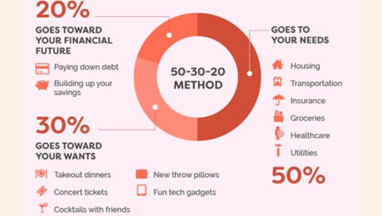The Art of Budgeting - Your Ultimate February Guide and 6-Month Roadmap
January was all about mapping the treasure – understanding your income and expenses. Now, in February, we embark on a thrilling quest: crafting your financial compass – the budget!
Remember all those categories you meticulously tracked last month? They become the building blocks of your budget, a roadmap that guides your spending and steers you towards your financial goals. But how do we navigate this budgeting terrain? Fear not, for we have a trusty tool at our disposal – The 50/30/20 rule.
The 50/30/20 Rule: Your Financial GPS
Imagine a pie chart, divided into three delectable slices. The 50/30/20 rule allocates these slices to different spending categories:
- 50% Needs: The essentials that keep your life running smoothly. Think rent/mortgage, groceries, utilities, transportation etc
- 30% Wants: Now for the fun part! This slice caters to your desires, the things that bring you joy. Entertainment, dining out, shopping, hobbies,subscriptions – these are the sprinkles on your financial cupcake, adding sweetness and flavour to your life. Remember, responsible wants don't derail your journey, they enrich it!
- 20% Savings and Investments: This is the slice that secures your future. It can be building an emergency fund, saving for a down payment, or investing for long-term goals like retirement. This slice might seem small now, but its power compounds over time.

Making Your Budget a Reality:
- Gather your supplies: You'll need your January expense tracker (remember those categories?), a calculator, and a healthy dose of determination.

2. Calculate your Net Income: Refer to your January newsletter to revisit your net income calculation. This is the total amount you have available to spend, save, and invest each month.
3. Divide and Conquer: Apply the 50/30/20 rule to your net income. Allocate 50% to needs, 30% to wants, and 20% to savings and investments.
4. Sub-categorize: Break down your needs and wants categories further. For example, "needs" could include groceries, transportation, and rent, while "wants" could include entertainment, dining out, and clothing. This level of detail helps you track your spending more effectively.
5. Track and Adjust: Remember, budgeting is a continuous journey. Regularly monitor your spending against your allocated amounts. If you're overspending in one category, adjust another to compensate. Don't be afraid to tweak your budget as needed – flexibility is key!
Remember! Consistency is key. Sticking to your budget may require some discipline, but the rewards are immense. You'll gain control over your finances, reduce stress, and make significant progress towards your financial goals.
February is just the beginning of your budgeting adventure! In the coming months, we'll delve deeper into specific aspects of financial management, like choosing the right saving and investment techniques for you, debt-free savings plan, and building your emergency fund. So, stay tuned.
Women shouldn’t shy away from discussing finance. This is the only way to break the walls and set a level playing field. Let’s be unstoppable. We've all heard the saying, "Be the change you wish to see in the world." This is for all the ladies out there, come join FIKAA to empower women so they can learn, invest, connect, and grow together.
If you like this post, don't forget to subscribe to FIKAA Newsletter, follow our FIKAA page and download our app.